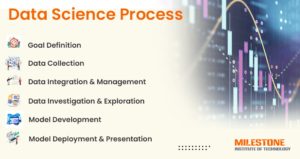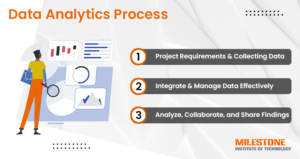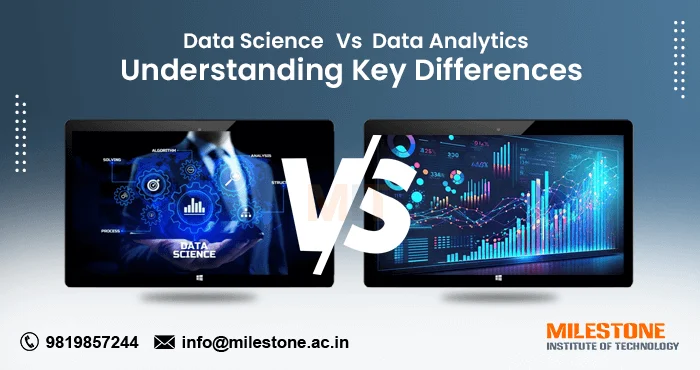In the dynamic realm of data-driven decision-making, distinguishing between data science and data analytics is crucial. Data science involves the comprehensive exploration and modeling of complex datasets, often using machine learning for predictive insights. On the other hand, data analytics focuses on interpreting historical data to extract actionable information. In this blog – “
Data Science vs Data Analytics“, you will understand the key differences and get clarity on which will be the best choice between both for your career.
Data Science – Definition:
Data Science is a multidisciplinary field that encompasses a broad range of techniques, algorithms, and processes to extract meaningful insights and knowledge from structured and unstructured data. It involves the integration of various domains such as statistics, mathematics, computer science, and domain-specific knowledge to uncover hidden patterns and trends.
Data Scientists are responsible for developing complex models, designing algorithms, and creating predictive analytics. They often work with large datasets, utilizing advanced programming languages like Python or R and frameworks such as
TensorFlow or PyTorch. Data Science aims to solve complex problems and generate actionable insights for strategic decision-making.
Data Analytics – Definition:
The goal of data analytics is to find patterns, correlations, and trends in past data through analysis. It primarily deals with structured data and employs statistical methods and tools to draw conclusions. Data Analysts play a crucial role in transforming raw data into understandable information, providing valuable insights to support business decisions.
Data Analytics involves a more specialized skill set, including proficiency in tools like SQL, Excel, and visualization tools like Tableau or Power BI. The primary objective of Data Analytics is to answer specific business questions, optimize processes, and enhance overall efficiency.
Data Science Process: Transforming Data into Actionable Insights
Data science is a dynamic and iterative process that empowers organizations to extract valuable insights from vast amounts of data. The journey from raw information to actionable intelligence involves a systematic approach, often broken down into distinct stages. Here’s a comprehensive overview of the data science process:

Goal Definition – Setting the Analytical Stage:
The journey begins with a clear understanding of the objectives. Define the goals and questions you aim to answer through
data analysis. Establishing a well-defined goal ensures that the analytical efforts remain focused and aligned with the broader organizational objectives.
Data Collection – Building the Foundation:
Accurate and relevant data is the cornerstone of any successful data science endeavor. Collecting data from diverse sources, be it structured databases or unstructured text, forms the foundation for subsequent analyses. Thorough data collection lays the groundwork for robust insights.
Data Integration & Management – Transforming Raw Data:
The process of merging data from several sources to provide a single, cohesive view is known as data integration. Managing and cleaning the data ensures that it is consistent, accurate, and ready for analysis. This stage is crucial for overcoming data quality challenges and preparing the dataset for further exploration.
Data Investigation & Exploration – Unveiling Patterns:
In this exploratory phase, data scientists delve into the dataset to uncover patterns, trends, and potential relationships. Various statistical and visualization techniques are employed to gain a deeper understanding of the data. Exploratory data analysis helps identify potential insights that can guide subsequent modeling efforts.
Model Development – Crafting Analytical Solutions:
Building predictive models or algorithms is at the heart of the data science process. Using machine learning techniques, data scientists develop models that can make accurate predictions or classifications based on the patterns identified during exploration. This step involves training, testing, and refining the models until they achieve optimal performance.
Model Deployment and Presentation – Transforming Insights into Action:
Once the model is ready, it needs to be deployed for practical use. This involves integrating the model into existing systems, creating user interfaces, and making it accessible for decision-makers. Presenting the findings in a comprehensible manner is crucial for facilitating informed decision-making and driving actionable results.
Data Analytics Process
The data analytics process is a systematic approach to extracting meaningful insights and knowledge from raw data. It involves a series of steps designed to uncover patterns, trends, and correlations that can inform decision-making and drive business outcomes. Lets see the actual steps which will help you to understand data analytics process.

Project Requirements & Collecting Data:
Initiate the data analytics journey by clearly outlining project objectives and collecting relevant data. Understanding the specific needs ensures a targeted and effective analysis.
Integrate & Manage Data Effectively:
Seamlessly blend diverse datasets through robust integration methods. Prioritize data quality and consistency, enabling a comprehensive management system to support accurate and reliable analytics.
Analyze, Collaborate, and Share Findings:
Employ advanced analytics tools to dissect the integrated data. Foster collaboration among team members to harness diverse perspectives, ensuring a thorough analysis. Finally, share insights across the organization, promoting informed decision-making based on the data-driven discoveries.
Skill Sets and Roles:
While there is some overlap in skill sets, Data Scientists and Data Analysts possess distinct competencies and fulfill different roles within an organization:
Data Science Skills and Roles:
- Programming: Proficiency in languages like Python, R, or Java.
- Machine Learning: In-depth knowledge of machine learning algorithms and frameworks.
- Statistical Analysis: Advanced statistical skills for model validation and interpretation.
- Data Wrangling: Expertise in cleaning, transforming, and preprocessing diverse datasets.
- Domain Knowledge: Understanding of the business context and industry-specific challenges.
- Communication: Ability to convey complex findings to non-technical stakeholders.
Data Scientists often work on strategic projects, designing and implementing models to solve complex business problems.
Data Analytics Skills and Roles:
- SQL: Proficient in querying databases to retrieve and manipulate data.
- Excel: Strong skills in data manipulation, analysis, and visualization.
- Data Visualization: Ability to create compelling visualizations using tools like Tableau or Power BI.
- Statistical Analysis: Basic statistical knowledge for drawing conclusions from data.
- Business Acumen: Understanding of business processes and objectives.
- Communication: Clear communication of insights to support operational decision-making.
Data Analysts play a critical role in providing actionable insights for day-to-day operations, contributing to the efficiency and effectiveness of business processes.
Key Differences Between Data Science and Data Analytics:
Now that we have explored the fundamental concepts of Data Science and Data Analytics, let’s delve into the data science vs data analytics that set these two fields apart:
Scope and Purpose:
- Data Science has a broader scope, covering the entire data lifecycle and employing advanced techniques to gain insights, build models, and deploy solutions for complex problems.
- Data Analytics has a more focused scope, primarily dealing with historical data to understand past performance, identify trends, and make predictions for future decision-making.
Goal Orientation:
- Data Science is goal-oriented towards solving complex problems, making predictions, and driving innovation by leveraging advanced analytical techniques.
- Data Analytics is goal-oriented towards supporting business decision-making by providing insights, trends, and recommendations based on historical data.
Techniques and Tools:
- Data Science utilizes a wide array of advanced techniques and tools, including machine learning algorithms, deep learning, and big data technologies.
- Data Analytics relies on statistical analysis, data visualization tools, and traditional database management systems.
Complexity of Problems:
- Data Science typically addresses complex and intricate problems, requiring advanced modeling and algorithmic solutions.
- Data Analytics focuses on solving more straightforward problems related to descriptive and diagnostic analysis.
Conclusion
Data Science and Data Analytics play pivotal roles in the data-driven landscape, offering unique contributions. While Data Science involves advanced modeling and end-to-end data management, Data Analytics focuses on extracting insights from historical data. Despite their distinctions, both fields underscore collaboration in optimizing data assets. Businesses aspiring to craft effective data strategies should grasp these nuances. To delve deeper, consider enrolling in a
Data Science course for comprehensive understanding and harnessing the full potential of data.






